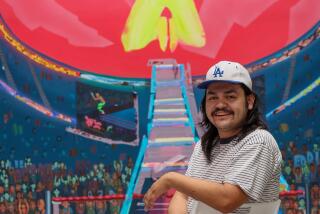SOS seen from a distance
On Sept. 2, 2005, four days after Hurricane Katrina slammed into the Gulf Coast with stupefying force, New Orleans’ Times-Picayune ran an enormous headline above a half-page photograph of a middle-aged woman kneeling in the street, her hands pressed together in prayer and agony smeared across her face. “Help Us, Please,” the headline pleaded.
It repeated the desperate words that Angela Antoinette Perkins had screamed the day before, imploring both the heavens and the journalists who had arrived at the scene of a living hell. The simple, shattering entreaty set off a chant -- help us, help us, help us -- among the tattered throng of survivors in front of the squalid shelter at the New Orleans Convention Center. The photograph, shot by the Times-Picayune’s Brett Duke, was picked up by hundreds of print and television outlets around the world and seen by millions.
A few weeks ago, a sign went up over Steve Turner Contemporary, a Wilshire Boulevard gallery directly across the street from the new Broad Contemporary Art Museum at the Los Angeles County Museum of Art. On black tarpaulin lying flat on the rooftop, capital letters in white paint implore, “HELP US.”
The sign is by artist Mark Bradford, whose mixed-media collage paintings are usually assembled from handbills, beauty parlor tissue paper, service advertisements posted on neighborhood fences and other such material, which he tears, layers, scrapes and weathers, often on large canvases. He calls his source material “the white noise of the street.”
The dense yet often lyrical paintings seek to tap into the random vitality born of an accumulation of urban signs. “HELP US” hits a different chord. Its street origins are the same, tracking memories of neighborhoods like the Lower 9th Ward, but its effect on a Los Angeles rooftop 30 months later is very different. This painting is a spectral ghost, haunting the private imagination and the national soul.
Bradford has positioned the painting out in the open but in a place where it cannot be seen. It’s located on a low roof surrounded by other low, mostly windowless buildings. To view it, you would probably need to be peering out the window of a low-flying aircraft.
That scenario recalls the notorious episode when President Bush flew over the drowned city of New Orleans in Air Force One at 2,500 feet, while returning to Washington from a Texas vacation. The photograph of Bush seated on a couch and gazing out the window, sheltered within a cocoon of power and disengaged from unspeakable earthbound suffering, is one of many visual metaphors for much American experience in the new millennium.
The other way to see Bradford’s painting, and the one most will employ, is on the Internet. A live feed on the gallery’s website records it, the constantly refreshed picture changing incrementally with the day’s passage into night.
Most people experienced the horror of Katrina that way, as imagery filtered through satellites, television cables, newspaper websites, cellphones and such. One of the nation’s worst natural disasters swirled within the raging electronic ether. Bradford’s plea, like the hurricane victims’, is designed to engage a phenomenon in which immediacy fuses with mediation -- an incongruous marriage -- and peering into a computer screen merges with looking at life (and death) out an airplane window.
Bradford painted his sign with a roller after outlining the text, beginning at the right and working toward the start. That means the bunching up of his lettering at the end, where the wobbly letter “S” is scrunched up against the canvas border as if he ran out of room, is in fact intentional. It recalls the cautionary letter “D” wedged in at the end of the familiar, jokey office sign that cautions workers to “Plan ahead.”
In the context of Katrina, riddled with failures to do exactly that, the warning assumes poignant power. Bradford is among more than 80 international artists now preparing to participate in “Prospect.1 New Orleans,” an invitational exhibition opening in Louisiana in November.
Notably, however, his L.A. rooftop painting only alludes to that specific tragedy. Its plea is more general.
The installation engages the typhoon vexing an increasingly wired world -- the pervasiveness of digitally mediated experience -- with its unfamiliar, inescapable, constantly pressing demands for new ways of thinking and feeling. You sit staring into a screen that begs you to help. And the sign blurts a thought and feeling shared by many. “HELP US” can also be read as “HELP U.S.” Like a shipwrecked sailor on a deserted island, Bradford is sending out an SOS of startling proportions.
--
christopher.knight @latimes.com
More to Read
The biggest entertainment stories
Get our big stories about Hollywood, film, television, music, arts, culture and more right in your inbox as soon as they publish.
You may occasionally receive promotional content from the Los Angeles Times.











